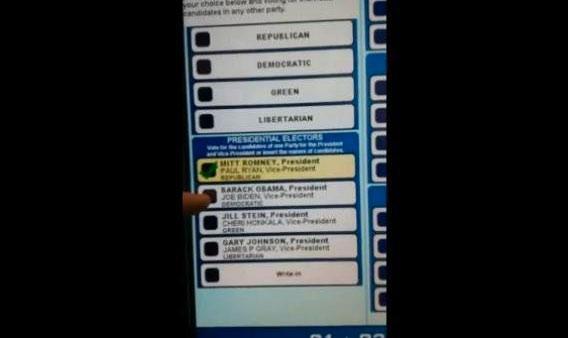Reddit, Twitter, cable news, and the universe at large have been figuratively blowing up today over a YouTube video that appears to show a Pennsylvania voter attempting to select “Barack Obama” on a voting machine and watching in alarm as the machine selects “Mitt Romney” instead. The video is embedded below.
The good news is that it’s unlikely this is an indication that anyone, man or machine, is trying to systematically steal the election. That’s partly because these sorts of glitches are actually not that uncommon on voting machines. Which I suppose is also sort of the bad news.
I spoke with David Dill, a computer science professor at Stanford and founder of the nonprofit watchdog group Verified Voting, to get his take on the apparent glitch. Dill told me it looks like a classic case of “vote-flipping,” a problem that has cropped up sporadically in U.S. elections since the dawn of voting machines. In many cases, Dill said, vote-flipping appears to be the result of improperly calibrated machines. Because the touchscreen surface is a separate transparent cover over the machine’s display, computer software is required to translate the position of the user’s touch to a position on the screen. Some models of voting machines must be calibrated by workers at the election center, e.g. by touching a rectangle in the corner of the screen. If they’re improperly calibrated, the user might think he’s touching one spot on the screen, while the machine thinks otherwise.
In the case of the Pennsylvania glitch, the user claims to have tested for this by touching other spots on the screen. From his explanation on Reddit and YouTube:
Being a software developer, I immediately went into troubleshoot mode. I first thought the calibration was off and tried selecting Jill Stein to actually highlight Obama. Nope. Jill Stein was selected just fine. Next I deselected her and started at the top of Romney’s name and started tapping very closely together to find the ‘active areas’. From the top of Romney’s button down to the bottom of the black checkbox beside Obama’s name was all active for Romney. From the bottom of that same checkbox to the bottom of the Obama button (basically a small white sliver) is what let me choose Obama. Stein’s button was fine. All other buttons worked fine.
Of course, we don’t know for sure whether he actually did all that, because the video only shows him tapping “Obama” and watching it come up “Romney.” It’s conceivable that the whole thing is a hoax. But if it is true, Dill said, it could be evidence of a software problem, if the software on this particular machine allows for some button sizes to be set larger than others.
Could someone with access to the machines have done such a thing intentionally to try to sway the election in a key state? Theoretically, perhaps, but not likely. Computer scientists have long worried that voting machines are vulnerable to hacking, and some have gone ahead and hacked them to prove it. But Dill points out that if you were going to the trouble of hacking a machine’s software, “You could just as easily program the machines to commit fraud without displaying the wrong vote on the screen.”
The machine in question appears to be an ES&S iVotronic, a model infamous among experts for (apparently accidental) “vote-flipping.” A senior staff techologist at the Center for Democracy and Technology went further than Dill, telling Gawker it was “obviously miscalibrated.” In any case, the offending device has now been taken out of service, according to NBC News.
It’s worth noting that such vote-flipping episodes in the past have appeared to affect candidates from both parties. A quick YouTube search turns up plenty of examples.
On the whole, this incident seems less alarming in and of itself than as yet another symptom of a disjointed and technologically backward voting system in which different states and districts adopt different technologies for different reasons with little assurance of adequate vetting, transparency, or impartial oversight. Anthony Wing Kosner in Forbes yesterday challenged the nation’s tech press: “Why are we expending so much effort on the fine points of the new iPhone when our elections are being conducted on the equivalent of ancient feature phones?”
If there’s any consolation, Dill says, it’s that blatant malfunctions of this sort have dampened most jurisdictions’ enthusiasm for voting machines, and they appear to be falling out of favor.
